

Converging Digital Specimens and Extended Specimens - Towards a global specification for data integration - Digital/Extended Specimen - GBIF community forum. SR2020 interactive paginated. Release notes. No one-size-fits-all solution to clean GBIF. Introduction Publicly available species distribution data have become a crucial resource in biodiversity research, including studies in ecology, biogeography, systematics and conservation biology.
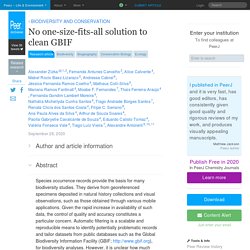
In particular, the availability of digitized collections from museums and herbaria and citizen science observations has increased drastically over the last few years. As of today, the largest public aggregator for geo-referenced species occurrences data, the Global Biodiversity Information Facility ( provides access to more than 1.5 billion geo-referenced occurrence records for species from across the globe and the tree of life. A central challenge to the use of these publicly available species occurrence data in research is problematic geographic coordinates, which are either erroneous or unfit for downstream analyses (for instance because they are overly imprecise, Anderson et al., 2016).
Problematic records are especially critical in conservation, where stakes are high. Newsletters. Publishing sequence-derived data through biodiversity data platforms [Community review draft] New data-clustering feature aims to improve data quality and reveal cross-dataset connections. GBIF has released a first version of a data-clustering algorithm that identifies potentially related records by matching similar entries in individual fields across different datasets.
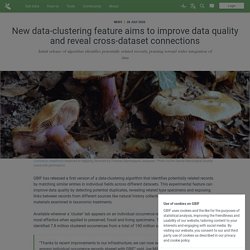
This experimental feature can improve data quality by detecting potential duplicates, revealing related type specimens and exposing links between records from different sources like natural history collections, DNA-derived sequences and materials examined in taxonomic treatments. Available wherever a ‘cluster’ tab appears on an individual occurrence record the new feature is likely most effective when applied to preserved, fossil and living specimens.
The initial implementation has identified 7.8 million clustered occurrences from a total of 190 million specimen records. "Thanks to recent improvements to our infrastructure, we can now explore deeper relationships among individual occurrence records shared with GBIF," said Joe Miller, GBIF Executive Secretary. Twenty years of GBIF: Independent review charts successes and challenges. The most comprehensive review of GBIF’s activities in more than a decade has offered a series of recommendations that aim to build on its achievements to date while addressing a range of challenges to secure the network’s future.
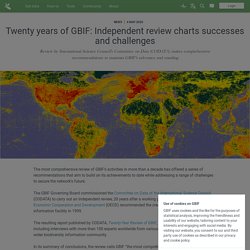
The GBIF Governing Board commissioned the Committee on Data of the International Science Council (CODATA) to carry out an independent review, 20 years after a working group of the Organization for Economic Cooperation and Development (OECD) recommended the creation of a global biodiversity information facility in 1999. The resulting report published by CODATA, Twenty-Year Review of GBIF, follows a year of research, including interviews with more than 100 experts worldwide from various parts of the GBIF network and wider biodiversity information community. “Consequently, as a global, distributed platform, GBIF is viewed widely as being a major success and a great improvement over alternative solutions,” the report concludes. Advancing the Catalogue of the World's Natural History Collections - Collections Catalogue - GBIF community forum.
GRSciColl: The Global Registry of Scientific Collections. GRSciColl is a comprehensive, community-curated clearinghouse of information about object-based scientific collections.
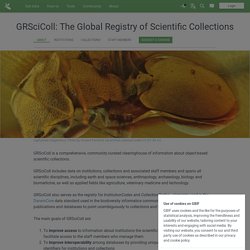
GRSciColl includes data on institutions, collections and associated staff members and spans all scientific disciplines, including earth and space sciences, anthropology, archaeology, biology and biomedicine, as well as applied fields like agriculture, veterinary medicine and technology. GRSciColl also serves as the registry for InstitutionCodes and CollectionCodes—elements used in the DarwinCore data standard used in the biodiversity informatics community. Use of these terms enables publications and databases to point unambiguously to collections and their contents. The main goals of GRSciColl are: The next phase of development will open the registry to validated users for submissions and edits. Virtual workshop: Advancing the Catalogue of the Worlds Natural History Collections.
On behalf of numerous partners and stakeholders, GBIF will convene a virtual workshop and international consultation in March and April 2020 with the aim of fleshing out a shared vision, road map and set of priorities for developing the scope, content and services included in a catalogue of the world's natural history collections.
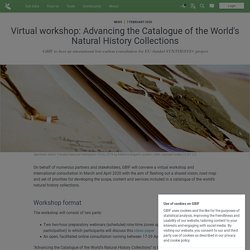
Workshop format The workshop will consist of two parts: Two two-hour preparatory webinars (scheduled nine time zones apart to support wider global participation) in which participants will discuss this ideas paperAn open, facilitated online consultation running between 17-29 April 2020. Which tools can I use to share my data on GBIF? - GBIF Data Blog. As you probably already know, GBIF.org doesn’t host any data.
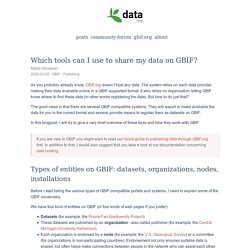
The system relies on each data provider making their data available online in a GBIF-supported format. It also relies on organization letting GBIF know where to find these data (in other words registering the data). But how to do just that? The good news is that there are several GBIF-compatible systems. They will export or make available the data for you in the correct format and several provide means to register them as datasets on GBIF. Advancing the Catalogue of the World’s Natural History Collections. Information about natural history collections helps to map the research landscape and assists researchers in locating and contacting the holders of specimens.
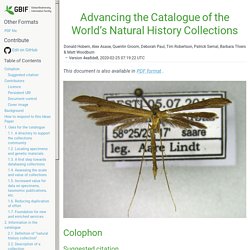
Collection records contribute to the development of a fully interlinked biodiversity knowledge graph, showcasing the existence and importance of museums and herbaria and supplying context to available data on specimens. These records also potentially open new avenues for fresh use of these collections and for accelerating their full availability online. This document explores ideas for improved global collaboration to build, maintain and use a comprehensive catalogue of the world’s natural history collections. Each idea is presented as a separate topic with a set of questions to guide discussion within the online consultation, Advancing the Catalogue of the World’s Natural History Collections. Many established use cases for standardised collection information relate primarily to preserved biological collections. Does Biodiversity Informatics □ Wikidata? - GBIF Data Blog.
Open online APIs are fantastic!
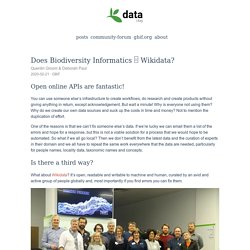
You can use someone else’s infrastructure to create workflows, do research and create products without giving anything in return, except acknowledgement. But wait a minute! Why is everyone not using them? Why do we create our own data sources and suck up the costs in time and money? Not to mention the duplication of effort. One of the reasons is that we can’t fix someone else’s data. Is there a third way? What about Wikidata? By Andrawaag - Own work, CC0, 50.000th GBIF dataset: a brief history. On January 8, 2020 Plazi had the good luck and honor to be the mediator of GBIF's 50.000th dataset.
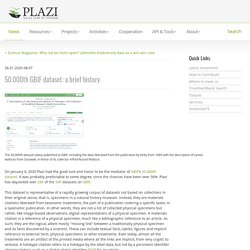
It was probably predictable to some degree, since the chances have been over 56%. Mobilization of biodiversity data from the private sector. The data flow for Norwegian biodiversity information used for public management and assessment of environmental impact from road and other large construction projects is already well-coordinated with GBIF Norway and the Norwegian Biodiversity Information Centre (NBIC).
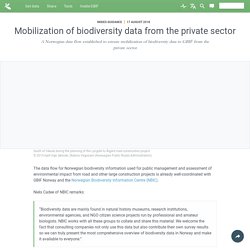
Niels Cadee of NBIC remarks: “Biodiversity data are mainly found in natural history museums, research institutions, environmental agencies, and NGO citizen science projects run by professional and amateur biologists. NBIC works with all these groups to collate and share this material. We welcome the fact that consulting companies not only use this data but also contribute their own survey results so we can truly present the most comprehensive overview of biodiversity data in Norway and make it available to everyone.” 2016 GBIF Ebbe Nielsen Challenge: Analysing and addressing gaps and biases in primary biodiversity data - Devpost. Using filters and facets on GBIF.org. GBIF. GBIF at 1 billion - what's next? GBIF has reached 1 billion occurrences which is, of course, something to celebrate: #GBIF1billion has arrived!
Merci beaucoup, @Le_Museum @INPN_MNHN et @gbiffrance! Thanks and congratulations, too, to the 1,217 data publishers and 92 participants who make the GBIF network go! More details to follow Thursday (champagne doesn't drink itself)… pic.twitter.com/xQ2f5fIt2x— GBIF (@GBIF) July 4, 2018 An achievement on this scale represents a lot of work by many people over many years, years spent developing simple standards for sharing data, agreeing that sharing is a good thing in the first place, tools to enable sharing, and a place to aggregate all that shared data (GBIF). So, I asked a question: So I guess the real #GBIF1billion question is what can we do with a billion data points that we couldn't do with, say, a hundred million?
My point is not to do this: Hey, don't spoil the party! GBIF Spain. Viet Nam joins GBIF. Top tip: Using filters and facets on GBIF.org. GBIF: UK 2nd-largest country publisher. GBIF: Manual of the Alien Plants of Belgium. The Manual of the Alien Plants of Belgium is a species checklist dataset published by the Botanic Garden Meise. It contains information on all (over 2.500) non-native vascular plants occurring in the wild in Belgium since 1800. We have released this dataset to the public domain under a Creative Commons Zero waiver. We would appreciate it if you follow the GBIF citation guidelines ( when using the data. If you have any questions regarding this dataset, don’t hesitate to contact us via the contact information provided in the metadata or via. BID as part of GBIF. GBIF. This year, the Global Biodiversity Information Facility (GBIF) established three task groups to help improving the data mobilized through GBIF.org.
One group has been devoted to give recommendations on the data required to produce species distribution modelling, a second group has been working on strategies to accelerate the discovery of bio-collections data, while the third group has been working in suggestions to improve the quality and quantity of agrobiodiversity related data available through the portal. GBIF Science Review 2019.